Menora (dance)
| Menora (dance) |
|---|
 |
|
| Burma |
| Cambodia |
|
| Indonesia |
|
| Laos |
|
| Malaysia |
| Philippines |
| Thailand |
| Vietnam |
Menora (Jawi: منورا) is a type of dance drama originating in Southern Thailand and practised mainly in the northern states of Malaysia and southern provinces of Thailand. Menora is also known as Manora (มโนราห์, มโนห์รา; pronounced [mā.nōː.rāː]) or Nora (โนรา; [nōː.rāː]) in Thai language.[1]
The basic features of the performance include a lengthy invocation, a dance by the main character, and a play or skit. The invocation is enacted by slow rhythmic movements of legs, arms and fingers.[2] The dramatic repertoire of Menora performance is based on Thai legends of Manohara, derived from the Buddhist Jataka tales, many of which already accultured into Malay society centuries ago.[3]
In the northeastern state of Kelantan and Terengganu, Menora incorporates much use of Malay language and a mak yong-style dance movements. While in the northwestern state of Kedah, it is performed in a mixture of Thai and local dialects, but adheres to the invocation-play in a distinctly north Malaysian style and incorporates some elements of Jikey and Mek Mulung.[2]
The musical ensemble consists of a pair of hand cymbals, a pair of small knobbed gongs, a pair of wooden sticks, a barrel-shaped kendang, a reed instrument and a vase-shaped single headed drum.[1]
References[]
Further reading[]
- Ginsburg, Henry D. "The Menora dance-drama: an introduction". In: Journal of the Siam Society nr. 60. 1972. pp. 169-181.
- Hemmet, Christine. "Le Nora Du Sud De La Thaïlande: Un Culte Aux Ancêtres." Bulletin De L'École Française D'Extrême-Orient 79, no. 2 (1992): 261-82. Accessed June 17, 2020. www.jstor.org/stable/43731384.
- Kershaw, Roger. "A Little Drama of Ethnicity: Some Sociological Aspects of the Kelantan Manora." Southeast Asian Journal of Social Science 10, no. 1 (1982): 69-95. Accessed June 17, 2020. www.jstor.org/stable/24490909.
- "CORRIGENDA: A Little Drama of Ethnicity: Some Sociological Aspects of the Kelantan Manora." Southeast Asian Journal of Social Science 10, no. 2 (1982): 118. Accessed June 17, 2020. www.jstor.org/stable/24490818.
- Plowright, P. (1998). The Art of Manora: An Ancient Tale of Feminine Power Preserved in South-East Asian Theatre. New Theatre Quarterly, 14(56), 373-394. [doi:10.1017/S0266464X00012458]
- Sheppard, Mubin. "MANORA in KELANTAN." Journal of the Malaysian Branch of the Royal Asiatic Society 46, no. 1 (223) (1973): 160-70. Accessed June 16, 2020. www.jstor.org/stable/41492072.
- Simmonds, E. H. S. “‘Mahōrasop’ in a Thai Manōrā Manuscript.” Bulletin of the School of Oriental and African Studies, University of London, vol. 30, no. 2, 1967, pp. 391–403. JSTOR, www.jstor.org/stable/611002. Accessed 24 Apr. 2020.
- Simmonds, E. H. S. “‘Mahōrasop’ II: The Thai National Library Manuscript.” Bulletin of the School of Oriental and African Studies, University of London, vol. 34, no. 1, 1971, pp. 119–131. JSTOR, www.jstor.org/stable/614627. Accessed 24 Apr. 2020.
- Sooi-Beng, Tan. “The Thai ‘Menora’ in Malaysia: Adapting to the Penang Chinese Community.” Asian Folklore Studies, vol. 47, no. 1, 1988, pp. 19–34. JSTOR, www.jstor.org/stable/1178249. Accessed 24 Apr. 2020.
- Malay dances
- Thai dance
- Dances of Malaysia
- Malay Peninsula
- Peninsular Malaysia
- Southern Thailand
- Dance stubs
- Malaysia stubs

